Stock Market Correction Begins
Stock-Markets / Financial Markets 2009 Nov 21, 2009 - 12:52 PM GMT Do the Feds sense a Wil-e Coyote moment ahead?
Do the Feds sense a Wil-e Coyote moment ahead?
Federal Reserve officials are stepping up scrutiny of the biggest U.S. banks to ensure the lenders can withstand a reversal of soaring global-asset prices, according to people with knowledge of the matter.
Supervisors are examining whether banks such as JPMorgan Chase & Co., Morgan Stanley and Goldman Sachs Group Inc. have enough capital for the risks they take, how much they know about the strength of their counter parties and whether risk managers have authority to influence bank practices and policies.
Talk about a correction intensifies.
After a multi-month rally from the March lows, many investors are starting to think riskier assets are showing signs of fatigue. Add to that the possibility that the dollar – the perceived driver of much bullish activity – may be building a bottom from which to bounce, and the chatter about the start of the long-awaited “correction” intensifies.
You now have to pay to invest in safe assets.
Treasury three-month bill rates turned negative for the first time since financial markets froze last year on concern that the rally in higher-yielding assets has outpaced the prospects for economic growth. Investors were willing to pay the government to hold their money as stocks slid amid speculation the eight-month, 68 percent rally that drove the valuation of the MSCI World Index to the most expensive level in seven years already reflects forecasts for a 25 percent rebound in corporate earnings next year.
The correction begins.
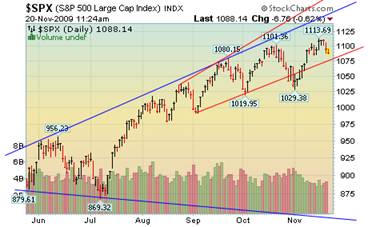 -- Stocks drifted lower Friday, continuing a two-day retreat, as investors remained jittery about the economy and the outlook for the technology sector.
-- Stocks drifted lower Friday, continuing a two-day retreat, as investors remained jittery about the economy and the outlook for the technology sector.
After climbing to a 13-month high earlier this week, the major indexes have fallen for two consecutive sessions amid worries about the economic recovery, the strengthening dollar, and the technology sector.
Will long-term treasuries follow the short-term rally?
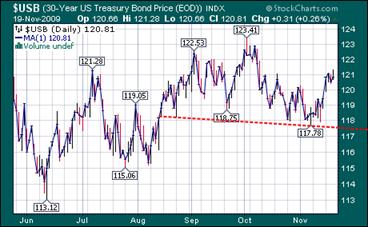 -- Short-term Treasury prices rallied again on Friday, sending yields on 2-year notes to the lowest this year, as investors step away from riskier assets to lock in profits as 2009 winds down. The market is also reflecting increasing concerns that the U.S. economy won't rebound from the recession as quickly or strongly as markets had accounted for, especially after Federal Reserve Chairman Ben Bernanke said earlier this week that extremely low interest rates would be merited for some time.
-- Short-term Treasury prices rallied again on Friday, sending yields on 2-year notes to the lowest this year, as investors step away from riskier assets to lock in profits as 2009 winds down. The market is also reflecting increasing concerns that the U.S. economy won't rebound from the recession as quickly or strongly as markets had accounted for, especially after Federal Reserve Chairman Ben Bernanke said earlier this week that extremely low interest rates would be merited for some time.
The dollar rally may curb gold prices.
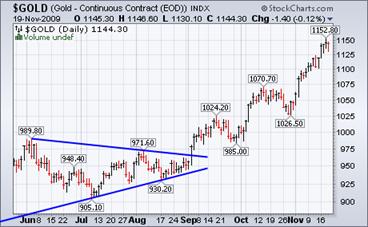 -- Gold futures dropped as the dollar’s rebound curbed demand for the precious metal as an alternative investment. The dollar gained as much as 0.8 percent against a basket of major currencies as short-term Treasuries climbed and equities fell. Before today, gold rose 9.8 percent this month, reaching a record $1,153.40 an ounce on Nov. 18. Traders are becoming concerned about the dollar rally.
-- Gold futures dropped as the dollar’s rebound curbed demand for the precious metal as an alternative investment. The dollar gained as much as 0.8 percent against a basket of major currencies as short-term Treasuries climbed and equities fell. Before today, gold rose 9.8 percent this month, reaching a record $1,153.40 an ounce on Nov. 18. Traders are becoming concerned about the dollar rally.
Could the Japanese market be leading this decline?
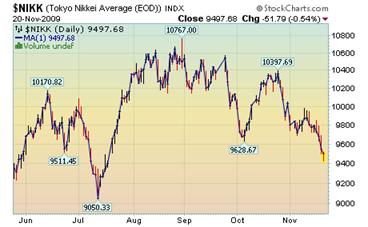 -- Japanese stocks fell 0.5 percent to 9497.68, a four-month low, as Sony sank 2.4 percent to 2,410 yen. The Tokyo-based maker of Bravia televisions is aiming for a 10 percent return on equity by March 2013, pushed back from its previous target of March 2011, Sony said yesterday. It’s also forecasting a net loss of 95 billion yen ($1.07 billion) this fiscal year after losing 98.9 billion yen the previous year. This could be the source of a global meltdown.
-- Japanese stocks fell 0.5 percent to 9497.68, a four-month low, as Sony sank 2.4 percent to 2,410 yen. The Tokyo-based maker of Bravia televisions is aiming for a 10 percent return on equity by March 2013, pushed back from its previous target of March 2011, Sony said yesterday. It’s also forecasting a net loss of 95 billion yen ($1.07 billion) this fiscal year after losing 98.9 billion yen the previous year. This could be the source of a global meltdown.
China’s market climb halts today.
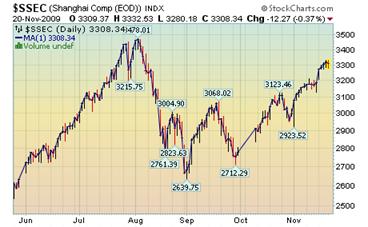 -- China’s stocks dropped the most in three weeks after the government raised electricity prices for the first time in 16 months, fueling concern that recent gains outpaced prospects for earnings growth. “The increase in power prices raises production costs and inflationary expectations,” said Larry Wan, the Shanghai-based deputy chief investment officer at KBC-Goldstate Fund Management Co. “The market is also due for a breather after the gains this quarter.”
-- China’s stocks dropped the most in three weeks after the government raised electricity prices for the first time in 16 months, fueling concern that recent gains outpaced prospects for earnings growth. “The increase in power prices raises production costs and inflationary expectations,” said Larry Wan, the Shanghai-based deputy chief investment officer at KBC-Goldstate Fund Management Co. “The market is also due for a breather after the gains this quarter.”
The dollar may be putting in a bottom.
 The dollar rose against all of its major counterparts and climbed for a second day against the euro as investors sold shares and bought short-term Treasuries to reduce the chance of losses before the end of the year. “The market is reducing its exposure to risk and moving into U.S. Treasuries,” said Vassili Serebriakov, a currency strategist at Wells Fargo & Co. in New York. “The dollar is benefiting.”
The dollar rose against all of its major counterparts and climbed for a second day against the euro as investors sold shares and bought short-term Treasuries to reduce the chance of losses before the end of the year. “The market is reducing its exposure to risk and moving into U.S. Treasuries,” said Vassili Serebriakov, a currency strategist at Wells Fargo & Co. in New York. “The dollar is benefiting.”
FHA may be the next train wreck.
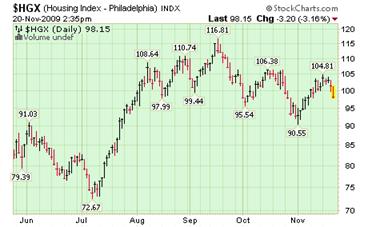 -- The Federal Housing Administration, the agency that insures home purchases made with down payments as small as 3.5 percent, may create another lending crisis, Toll Brothers Inc. Chief Executive Officer Robert Toll said. “Yesterday’s subprime is today’s FHA,” Toll said today at a New York conference for builders. “It’s a definite train wreck and the flag will go up in the next couple of months: Bail us out. Give us more money.” Toll Brothers is the largest U.S. luxury homes builder.
-- The Federal Housing Administration, the agency that insures home purchases made with down payments as small as 3.5 percent, may create another lending crisis, Toll Brothers Inc. Chief Executive Officer Robert Toll said. “Yesterday’s subprime is today’s FHA,” Toll said today at a New York conference for builders. “It’s a definite train wreck and the flag will go up in the next couple of months: Bail us out. Give us more money.” Toll Brothers is the largest U.S. luxury homes builder.
Ethanol doesn’t appear to be viable.
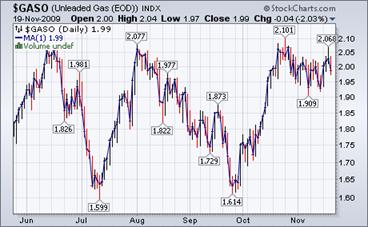 The Energy Information Agency weekly report suggests, “Capacity to produce fuel ethanol from corn nearly tripled between January 2006 and January 2009. However, over the past 18 months, a combination of surplus production capacity, the decline of gasoline prices from their mid-2008 peak level, and high corn prices that boosted producers’ input costs have resulted in a sharp decline in ethanol margins. The combination of economic pressures on capacity led some producers to idle plants, and in some cases, file for bankruptcy.”
The Energy Information Agency weekly report suggests, “Capacity to produce fuel ethanol from corn nearly tripled between January 2006 and January 2009. However, over the past 18 months, a combination of surplus production capacity, the decline of gasoline prices from their mid-2008 peak level, and high corn prices that boosted producers’ input costs have resulted in a sharp decline in ethanol margins. The combination of economic pressures on capacity led some producers to idle plants, and in some cases, file for bankruptcy.”
Higher NatGas prices not showing in the futures market.
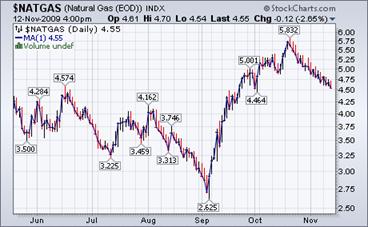 The Energy Information Agency’s Natural Gas Weekly Update reports, “Since last Wednesday, November 11, natural gas spot prices have exhibited significant variability. Prices initially declined early in the report week at market locations across the lower 48 States. In trading on Friday, November 13, price declines ranged between $0.61 and $1.08 per MMBtu. However, price increases since last Friday of between $1.20 and $1.71 more than offset the declines heading into the weekend.”
The Energy Information Agency’s Natural Gas Weekly Update reports, “Since last Wednesday, November 11, natural gas spot prices have exhibited significant variability. Prices initially declined early in the report week at market locations across the lower 48 States. In trading on Friday, November 13, price declines ranged between $0.61 and $1.08 per MMBtu. However, price increases since last Friday of between $1.20 and $1.71 more than offset the declines heading into the weekend.”
Exploring the dangers of a Global Collapse.
Société Générale has advised clients to be ready for a possible "global economic collapse" over the next two years, mapping a strategy of defensive investments to avoid wealth destruction.
In a report entitled "Worst-case debt scenario", the bank's asset team said state rescue packages over the last year have merely transferred private liabilities onto sagging sovereign shoulders, creating a fresh set of problems.
Overall debt is still far too high in almost all rich economies as a share of GDP (350pc in the US), whether public or private. It must be reduced by the hard slog of "deleveraging", for years.
Related Articles: 'Debt levels risk another crisis'
"As yet, nobody can say with any certainty whether we have in fact escaped the prospect of a global economic collapse," said the 68-page report, headed by asset chief Daniel Fermon. It is an exploration of the dangers, not a forecast.
Social Security Trust Fund: We are living off the interest.
The Social Security Trust Fund racked up another monthly deficit for October. The shortfall was $4.2 billion. This is the 5th consecutive month of red ink for the Fund. The total for the period comes to $15bil. Blame the economy and the boomers for this problem. Some basic measures of the Fund's performance are rapidly deteriorating.
A critical measure is the ratio of Payroll Tax receipts to Benefits paid. The following chart looks at that ratio over time. That ratio will fall below 1.0 for the full year 2009. As of today we are living off of the interest.
On November 20, 1930…
Market wrap: “Powerful support” by “important interests” for high-grade shares gradually broadened into advances in “a long list of representative shares.” Market showed resistance to bad news for second day; yesterday to wheat news, and today to failure of an Exchange firm. Bear attempt to start reaction around noon fizzled. Major industrials, auto shares, and utilities showed sustained strength; rails, entertainment shares, and some industrial specialties were up sharply.
Our Investment Advisor Registration is on the Web
We are in the process of updating our website at www.thepracticalinvestor.com to have more information on our services. Log on and click on Advisor Registration to get more details.
If you are a client or wish to become one, please make an appointment to discuss our investment strategies by calling Connie or Tony at (517) 699-1554, ext 10 or 11. Or e-mail us at tpi@thepracticalinvestor.com .
Anthony M. Cherniawski,
President and CIO
http://www.thepracticalinvestor.com
As a State Registered Investment Advisor, The Practical Investor (TPI) manages private client investment portfolios using a proprietary investment strategy created by Chief Investment Officer Tony Cherniawski. Throughout 2000-01, when many investors felt the pain of double digit market losses, TPI successfully navigated the choppy investment waters, creating a profit for our private investment clients. With a focus on preserving assets and capitalizing on opportunities, TPI clients benefited greatly from the TPI strategies, allowing them to stay on track with their life goals
Disclaimer: The content in this article is written for educational and informational purposes only. There is no offer or recommendation to buy or sell any security and no information contained here should be interpreted or construed as investment advice. Do you own due diligence as the information in this article is the opinion of Anthony M. Cherniawski and subject to change without notice.
Anthony M. Cherniawski Archive |
© 2005-2022 http://www.MarketOracle.co.uk - The Market Oracle is a FREE Daily Financial Markets Analysis & Forecasting online publication.



